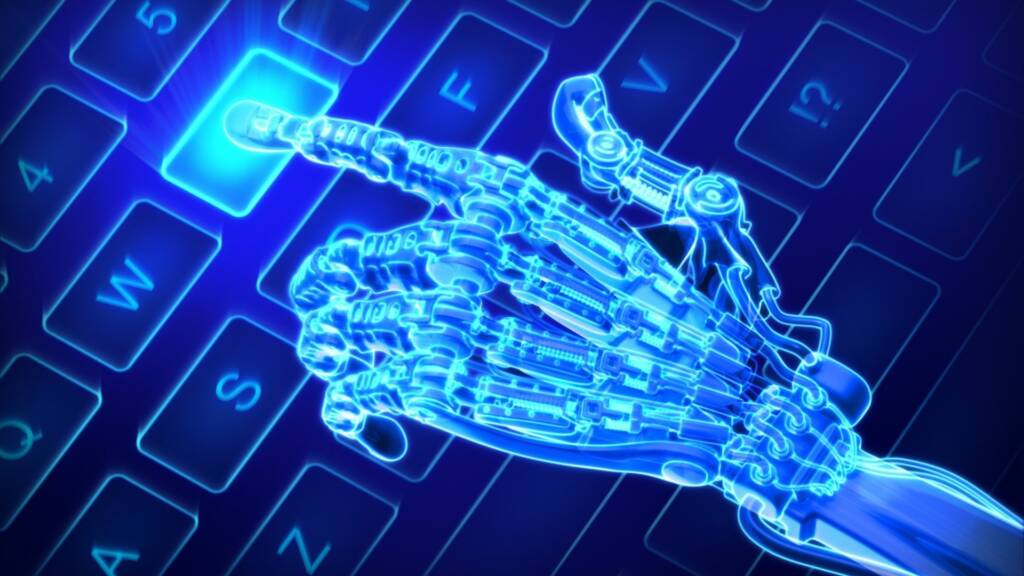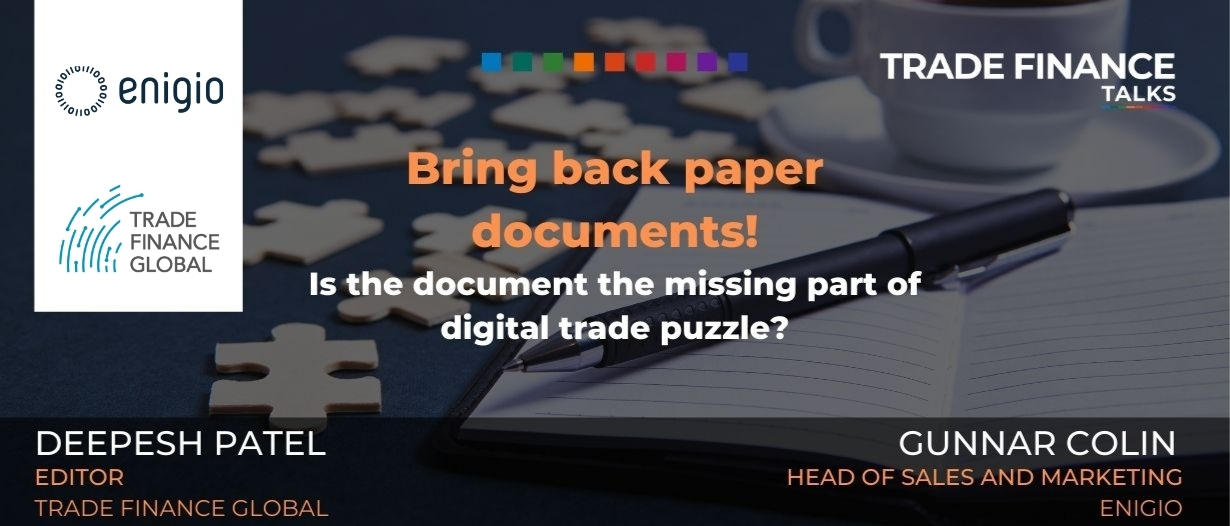Listen to this podcast on Spotify, Apple Podcasts, Podbean, Podtail, ListenNotes, TuneIn, PodChaser
Season 1, Episode 59
Host: Deepesh Patel (DP), Editor, Trade Finance Global
Featuring:
Gunnar Collin (GC), Head of Sales and Marketing, Enigio

Digitalization often takes over conversations when it comes to making trade more efficient. It’s well documented that trade is an incredibly paper-heavy, inefficient, unsustainable business right now, but the insurmountable task of ‘digitizing trade’ is rather complex. We argue that the paper document is the best standard in trade and it works, albeit with some challenges. By replicating how a paper document behaves and moving this online we might be able to address some major pain points? By understanding how paper documents work, we explore whether trace:original by Enigio, is an alternative way of approaching digital trade.

Deepesh Patel (DP): My name is Deepesh Patel, Editor at Trade Finance Global. Today, we take a break from the compulsory habits of bringing up standards and interoperability, we go back to the basics and talk about paper. I’m delighted to be joined by Gunnar Colin, head of sales and marketing at Enigio.
Gunnar, can you give us a quick introduction?
Gunnar Collin (GC): I’m from Sweden and am the head of sales and marketing at Enigio, a small tech company in the EU, where I am currently focused on marketing our solution, trace:original. I have worked for over 30 years in different banks, primarily in trade operations so I am very familiar with the inner trade finance operations of financial institutions.
The advantages of paper in trade
DP: Let us start by talking about paper. Can you explain the advantages of paper documents such as a bill of exchange?
GC: Yes, I do not really want to talk about the advantages of paper per se but focus more on what paper represents. When we think about digitization, we often focus on the content – what is written down on the piece of paper. We tend to forget that the actual document itself represents a lot. With paper you can clearly distinguish an original from a copy, you know what is and is not written, you are able to transfer the ownership just by handing over the physical sheet of paper to another person. These are some of the reasons why I think that there are advantages with paper documents.
DP: Would you say paper is one of the best standards in trade?
GC: It is a very basic standard. The traditional way of exchanging information is putting it down on a piece of paper and sending it. This is the way your counterparts expect to receive information. Paper is also versatile. If you have a piece of paper, you can make a bill of exchange, a bill of lading, an invoice, or any other type of content, and the receiver will be able to understand it. This is the forgotten standard. Today, everyone is screaming that we need everyone to agree on new standards and for the laws to change. This is over-ambitious. Of course, we could standardize many things but the sheet of paper is already a great standard.
DP: What is Enigio? Where did the idea come from?
GC: The background of Enigio is in archiving. Archiving is a science – one of the oldest sciences. It is key when you archive something that you know exactly what you are putting into the archives so that you can be 100% sure that you are pulling out the same thing tomorrow or 100 years from now.
My colleagues at Enigio are archiving experts and have begun approaching it from a technological lens. In effect, we have been focusing on creating technical solutions for managing, storing, retrieving, and interchanging digital data. After discussions with an old banking colleague of mine, who has had a long history of managing documents in banks we realized that everyone has difficulties digitizing the documents where you need to be in possession of the original, such as documents of title. This is how everything came together and we set out to work on the trace: original solution.

trace:original
DP: What is trace:original? Is it a digital negotiable instrument (DNI) can you briefly explain what DNI is?
GC: trace:original is digital paper. It was designed to digitize a freely negotiable instrument such as a bill of exchange. To do this there are a few key features of paper that you must replicate. The most important is the ability to distinguish an original from a copy. It is also necessary to ensure that the owner of the document, and only the owner of the document, can do things to it, such as writing on it, invalidating it, or transferring ownership to someone else.
Trace: original was also created to comply with current legislation. If you read current legislation, there are a lot of requirements on a negotiable instrument. Any document, especially a digital one, must be able to comply with all these requirements. We believe that trace: original complies with any requirement that is out there for a negotiable instrument. The only difference is that we are not on paper, we are digital. At the end of the day, for someone to decide to work with our digital documents, they need to be sure that they can stand in front of a judge and prove that they are the holder of the original that contains the written promise.
Don’t digitize everything, digitize the document
DP: I remember you said once, “don’t digitize everything, digitize the document”. Let us say I have got a hypothetical bill of exchange in my hand; how can this behave in a totally digital format?
GC: Where you have a piece of paper in your hand, we have a digital file. You can write on your piece of paper and we can easily replicate that by adding content to our digital file. The next step is for us to be able to prove what content is defined in the file. To do that we use what is called a hash algorithm. Hash algorithms are a mathematical way of verifying content. By recording the hash of a document, we can verify it at a later time.
In a way, we are also a blockchain company. We use the blockchain as a means of publishing evidence of the existence of this file. Once the file is created, content is added, and it is hashed, it exists as a “sealed container of data” in cyberspace and the hash goes on the blockchain. Now, anyone looking at this data file can check if the content has been manipulated. All they need to do is ‘show’ the file to the blockchain and it will confirm that this is indeed the original version or that no it has been tampered with in some way. You will notice here that by using this hash function, we are able to verify authenticity without storing any of the actual content of the file on the blockchain.
Generally, trade documents have value when two parties sign a promise for one to pay the other a certain amount. There are many methods to digitally sign a document and the exact method used does not matter to trace:original. The hash of the original document is digitally signed by all parties and then hashed again. With that second hash, those signatures become an integrated part of the document. This way it is always possible to prove the content as well as who signed it.
The next thing to consider is the transfer of ownership. This is controlled by a cryptographic key pair, consisting of a public key and a private key. Our system writes the public key into the document allowing the owner of the corresponding private key to use it, kind of like a pen, to write on the document. The owner can use this “pen” to add more content or even to set a different public key to the document – effectively changing the owner of the document. If this is done, the original owner no longer possesses ownership and whoever owns the private key corresponding to this new public key is the new owner of the document and can, in a similar way, update it as they see fit.

Accepting digital documents, e-signatures and UNCITRAL MLETR
DP: That makes sense. It is important to remember that this is complimentary to E-signatures.
The UNCITRAL MLETR has not been adopted everywhere in the world yet. How can trace:original documents be accepted in an English court of law?
GC: This solution was designed to comply with any laws. The English system uses the Bill of Exchange act of 1882. There is nothing explicitly in this act that necessitates paper per se, but there is a requirement that the bill of exchange is in tangible form, which means that at present our solution does not comply.
We have established a workaround with the International Trade and Forfaiting Association (IFTA). Essentially, you agree in the document that this is a normal payment undertaking, not necessarily a bill of exchange. This means that whatever agreement you write in the document is the agreement applicable to that instrument. This is not an ideal solution, but it is a good workaround for now.
We are quite confident that the UN’s Model Law for Electronic Transfer of Records (MLETR) will be adopted in English law. The MLETR ensures that if an instrument fulfills all of the requirements in current law, it should not be denied simply because it is digital. The law commission is studying this as we speak, and it has already been adopted in Bahrain and recently Singapore.
DP: Thank you. It is interesting to think about trade digitalization from a new lens. I look forward to speaking to you next time, hopefully about a live, real-world case study.
This podcast was produced in partnership with Enigio

































